Instagram is arguably the best social media platform for advertising. It has now become as large of an advertising platform as its parent corporation – Facebook.
Here’s what you should know.
Instagram is a premium ad space that boasts massive revenue-generation potential for businesses. However, if you have not yet started to advertise your brand on Instagram or, worse, don’t know how to run ads on Instagram, you are not thoroughly utilizing your business’s advertising budget.
There are several compelling reasons to begin using Instagram’s sponsored advertising features. Not only are we going to discuss them all here, but we will also teach you the ABCs of how to run Instagram ads.
Let’s get started!
What Is an Instagram Ad, and How Does It work?
Instagram is a photo and video sharing platform that enables users to take and upload photos to share with their followers. They can also apply numerous effects and filters to their photos/videos to enhance their visual appeal.
Products aren’t just photographed and described on this app. Instead, they are displayed in unconventional ways and are even presented by celebrities who employ unique strategies. This increases both effectiveness and trustworthiness, making Instagram an ideal platform for a brand’s visual storytelling.

An Instagram ad is a paid feature that promotes a brand’s products or services. An ad can be in the form of images or videos designated to appear within the user’s feed or story, as per a business’s needs.
Sharing breathtaking visuals is one of the best bets for any brand’s success with an Instagram ad. Almost any type of business can benefit from such an approach. Even the not-so-visually captivating business offerings can be rendered into eye-catching layouts for attracting the viewers’ attention.

L’Occitane creatively designed an Instagram ad to grab the most eyeballs with a yellow background contrasting the product’s blue packaging.
Why You Should Use Instagram Ads
There are plenty of great reasons for businesses to use Instagram for paid advertising, some of which are listed below.
1. Entice your audience in a visually creative way
Instagram provides immense potential for businesses to target the appropriate audience, display their products (even if they are not tangible), and develop relationships with their audience in a very creative and visually appealing way.
For instance, an attractive layout in Digital Marketer’s ad below renders an intangible service (blog post audits) into a visual treat.

2. Generate far-reaching brand awareness
Instagram is ideal for brand awareness campaigns and a great complement to straightforward, conversion-dependent campaigns via email or Facebook.
For instance, apart from being an incredibly visual platform employing video and image-based posts, Instagram offers hashtags, carousel posts, IGTV, Reels, and many other features that brands can use to create stunning brand awareness campaigns.
Such Instagram campaigns offer a far better promise of capturing their audience’s attention as well as their imagination.
3. Leverage Facebook’s vast suite of advertising tools
Instagram provides the same practical tools as Facebook to target people based on their interests, search terms, or correlation with your established core audience. This means you can make the most of Facebook’s demographic, behavioral as well as targeting options to increase your audience width on Instagram.
4. Incorporate actionable CTAs
Unlike organic traffic via Instagram’s posts, ads contain clickable URLs so that viewers can conveniently click to be redirected to signup forms, webpages, or your online eCommerce sites.
According to Instagram, stories that included a CTA had an 89% improved chance of driving results than those that didn’t.
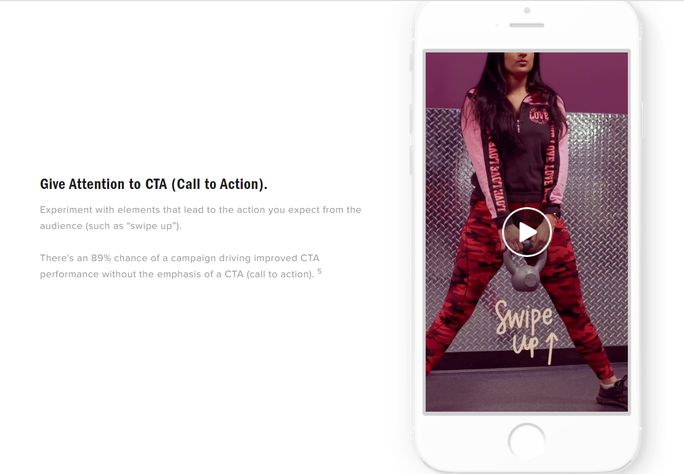
How To Run Instagram Ads
In this section, we will walk you through the step-by-step procedure of creating an ad of your choice, especially one that best represents your brand’s objectives and caters specifically to your target audience.
So, without further ado, let’s begin.
Step 1- Use the Facebook Ads Manager to start the process
For this step, you’d need to link your Instagram account with your business’s Facebook page.
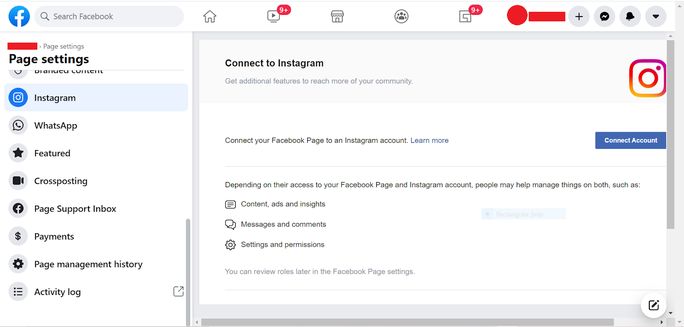
Once you’re done linking the two, your account on the Facebook Ads Manager would be ready.
Now, you’d need to click on the “+Create” button for flagging off a new Instagram ad campaign.

Step 2 – Choose your campaign’s objective
A campaign objective refers to the action you’d want your ad’s viewers to take. This is the most crucial step of the process. Here, you’ll need to assess your ad’s ultimate purpose for your business. Only then will you be able to decide on a single objective from the entire range available.

For instance, if you’d want your audience to make a purchase as per the payment information you plan to incorporate into your ad, then “Conversions” would serve as the best objective.
Given below is a list of other Instagram ad objectives.
- Brand awareness: Through this objective, you can reach out to those who are more inclined to notice your ads. You can raise brand recognition amongst them by targeting them specifically.
- Reach: Depending on your campaign’s schedule and budget, this goal makes your ad available to the broadest possible audience. This objective is best utilized when you wish to yield a massive impact on your audience at scale.
- Traffic: For redirecting more of your ad’s viewers to your app or website.
- Engagement: Get as many people as possible to interact with your ad. This interaction, aka engagement, can be through comments, likes, views, and event responses.
- App installs: Direct your viewers to an online store from where they can download or buy your business app.
- Video views: This objective involves attracting people to watch your brand’s video showcasing the products and services you offer.
- Conversions: You can use this objective when you’d like to encourage action on your app or website.
- Product Catalog Sales: You may select this objective to market items to recent visitors of your mobile app or website.
- Store Visits: Use this objective for targeting customers living in your business’s physical location and persuade them to visit your brick-and-mortar store.
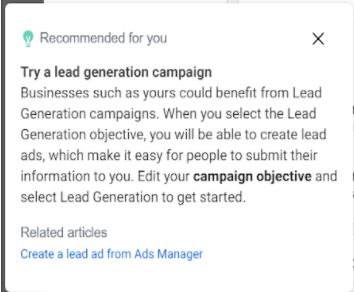
As soon as you choose your ad’s preferred objective, click on “Continue” to finish off the process.
You would end up with your campaign’s dashboard as shown below:

Step 3: Choose where you’d like to redirect your leads
If you have chosen the “Conversion” objective, Ads Manager will present you with 4 locations where your converts can be redirected after viewing your Instagram ad.
For instance, if you would like your viewers to visit your website after watching your ad, simply click the radio button next to “Website.” Similarly, you can choose among the app, Instagram Messenger and Whatsapp as your target conversion locations.

You can even use “Facebook Pixel”- Facebook’s built-in analytics tool-for gauging your objective’s performance.
Step 4: Define your target audience
This step is another crucial foundation stone on which your ad’s success would largely depend. Take your time to assess and determine your target audience’s geographical location, gender, age group, and native language spoken. Accordingly, update those details under the “Create New Audience” tab in your Ads Manager, as shown below.
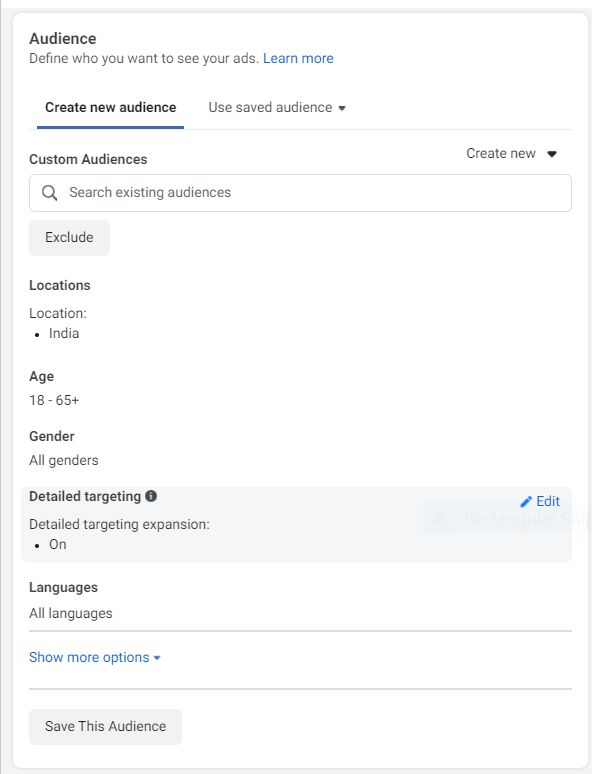
Do review the service terms for detailed targeting options, as discussed in the image below.

You can also build a custom audience that excludes Facebook’s built-in targeting options.

When you upload the database of your custom audience’s contact information, Facebook checks it to identify pre-existing profiles on its platform. Once that’s through, you can target those profiles via an Instagram ads

Facebook has an incredible resource for best practices while building a custom audience.
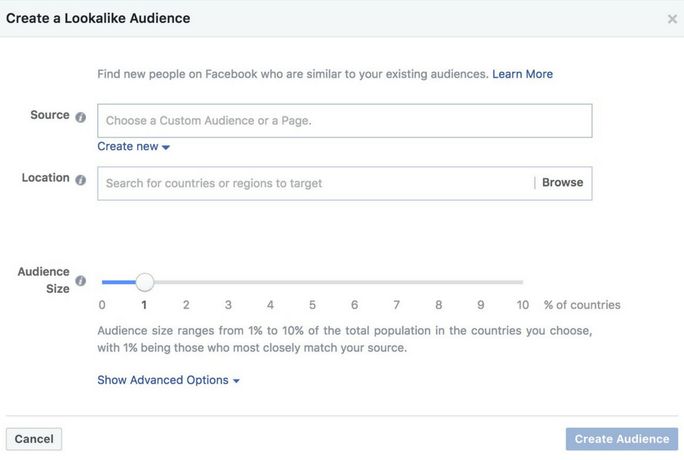
Step 5: Choose your ad’s placement
Ads Manager’s range of placements allows you to maximize your ad’s viewership in selected social media locations. Since you are creating an ad for Instagram, you can choose all Instagram-based locations under the “Manual placements” section.


Step 6: Set a budget and a schedule
The last step of creating your ad would involve selecting a schedule and budget for publishing it.
Your budget creation process would involve two options: daily budget and lifetime budget.
- A daily budget configures your ad to run constantly throughout the day, which means the algorithm will constantly pace your expenditure each day.
- A lifetime budget configures your ad to run for a certain amount of time, implying that the algorithm paces your expenditure over the selected time period.
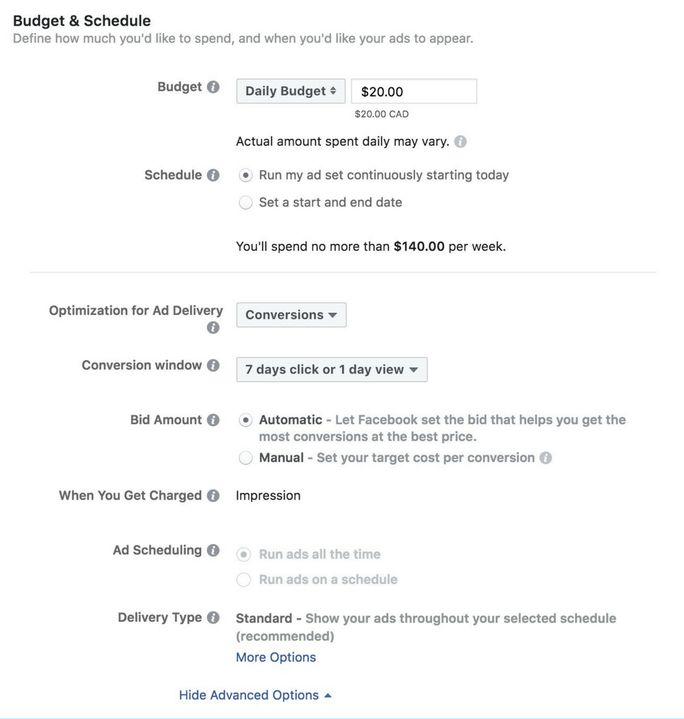
If you’re just getting started, it’s best to keep your ad expenditure minimal at first. Then, if your ad works well, you may easily raise the budget later.
How To Create a Compelling Instagram Ad
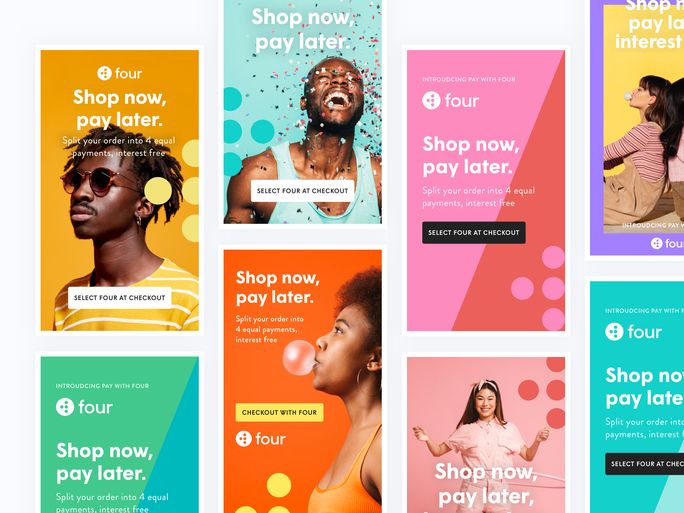
In this section, we will walk you through a step-by-step breakdown of creating great ads on Instagram. Magnetic visual elements aside, there are other components of a prolific Instagram ad you must pay attention to! We are going to discuss them all here.
Ready? Here we go!
1. Define your objective
Determine what action you would want your viewers to take after seeing your ad. An Instagram ad doesn’t bear a single purpose: it’s like a Swiss Army knife- versatile and adaptable.
Do you wish to promote a yet-to-be-launched product?
Share a unique offer?
Strengthen your brand awareness?
So, what do you do if your answer is yes to any of these questions? Define an objective that best reflects your advertising goals. It should be simple and straightforward to both you and your audience, right from the get-go!
Here’s an ad defined by a clear objective. Gym Shark Women ran a series of Instagram Story ads to announce their new product’s launch. The ads not only showcased their products but also encouraged viewers to take action faster via their CTA’s
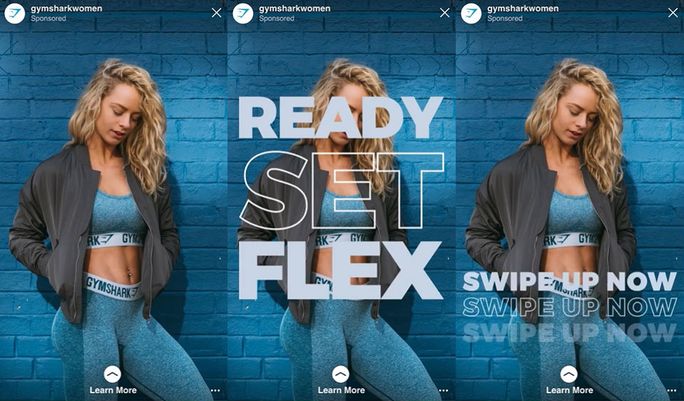
Meanwhile, J&Co Jewellery’s ad below used the Instagram Stories format to promote their limited-offer sale.

Your objective will be the foundational bedrock of your Instagram ad. So, take your time to research and choose the most appropriate one for your business needs.
2. Hone in on a specific audience segment
It may be tempting for you to keep your audience’s demographic filters wide open for reaching as many Instagram users as possible. However, focusing on a specific demographic sector can offer you more meaningful information about their interests and preferences, allowing you to fine-tune your ad’s structure.
To get started with defining your ideal audience, ask yourself: who does your brand cater to? Have a clear image of your typical buyer’s persona – likes, interests, motivations, and reasons for seeking your product or service. Analyze the ease of comfort your business offerings bring to their lives.
Here’s an example for your reference:
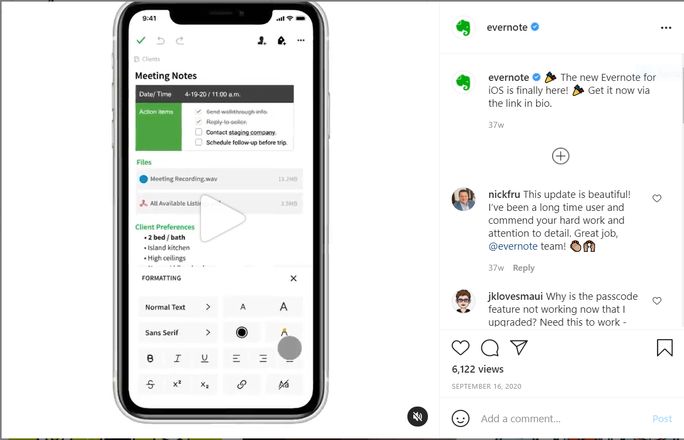
Evernote helps people organize their information and tasks. Hence, it is most likely to be used by students or professionals inundated with multiple assignments and deadlines. Given above is a screenshot from Evernote’s ad for their iOS app.
3. Elicit emotions
Analyze your target audience thoroughly. How would you like them to feel when they view your Instagram ad? What will pique their interest and entice them to take the action you’d want from them?
Your ad must deliver value to your intended audience. Only then, they’d be prompted to either click on the CTA button, or fill in your sign-up form, or perform any other action that would take to enhance your business.
You may, for example, use a playful image or a hilarious photo to pander to your audience’s sense of humor. Or you may evoke certain other moods pertinent to your business’ products or services.

Speaking of playful and hilarious images, consider Casper’s ad for its range of dog beds. Dog owners recognize their pet’s comical obsession with chasing squirrels all too well. Casper effectively utilized this well-known dog eccentricity in their ad, depicting a sleeping canine dreaming of squirrels. Both adorable and creative in equal parts, this ad resonated well with Casper’s dog-loving followers.
Let’s look at another example for greater clarity.

Consider this image ad from Garmin that infers dynamic motion without a muscle being moved! The hand tightly clenching the kegel ball, about to swing it into action, depicts just the kind of adrenaline rush that exercise enthusiasts can empathize with.
4. Retain or enhance your brand’s personality
Any ad that you create is an extension of your brand’s overall identity. The same applies to your ads on Instagram. Don’t weaken your brand’s ultimate message when focusing on your limited-period offer or deal. Make sure that you retain or even accentuate your brand’s personality in your Instagram ad, regardless of the format in use.

Starbucks’ Instagram ads always sport a bright color palette and fun captions, which are hallmarks of the brand’s vibrant personality. These are visible in one of its ads above.
How to Create a Successful Campaign
Now that we’re through with discussing how to create compelling Instagram ads let us continue with the elements of a successful Instagram ad campaign.
Designing an Instagram ad’s layout is one thing, but optimizing it to garner the desired views, reactions and conversions is a different ball game altogether. Regardless of the creative ingenuity employed for your ad’s design, if it does not fulfill your business’s goals, it’s just a glorified art piece put on display by your business.
Therefore, pay close attention to the best Instagram practices for running ads, gleaned from years of industry insights, listed below.
Clearly define your Instagram ad strategy
First of all, you must determine what you want to achieve with your Instagram ad campaign exactly. Set your goalposts right from the start.
If you aim to bring more awareness about a local event being organized by your brick-and-mortar store, you must carefully select your campaign strategy accordingly. Specific techniques, such as conducting contests or using hashtags, prove highly effective in generating awareness.

For instance, a contest ad organized by Hudson’s Cafe ensured both increased footfall to its restaurant as well as brand awareness.
If you just want to increase brand recognition, your possibilities can be more wide-ranging.
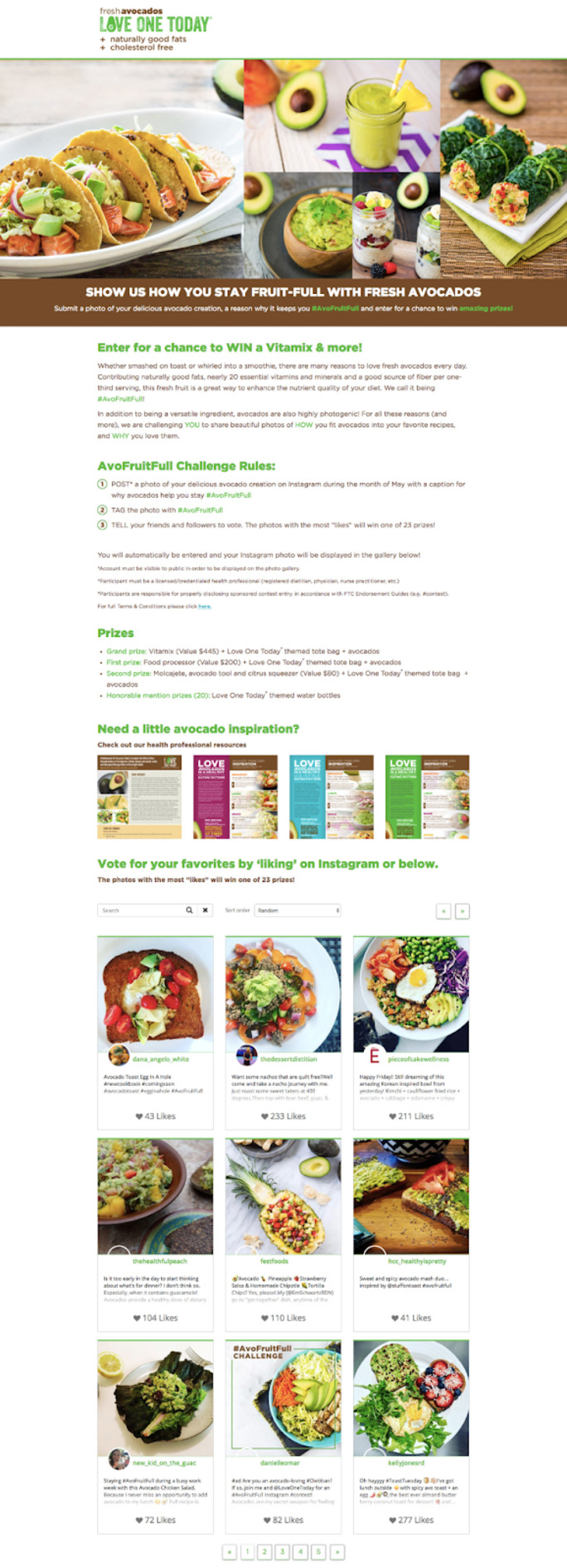
You can pick a hint from Love One Today’s Instagram contest that helped in strengthening their brand’s awareness.
They created an Instagram contest where their followers had to upload pictures of their unique avocado-based recipes with an adjoining explanation of the fruit’s benefits to their lives.
However, if your ultimate goal is increasing sales, you must devise a method to reach potential clients (offering discounts and deals is a viable method to boost sales, as DSW Canada did below)

Most (if not all) of your ads on Instagram should contain some kind of call to action (CTA). CTAs can often be a direct link to a sales page, though not always.
Optimize your Instagram ad placement
Given the range of placement options currently provided by Instagram Ads Manager (alternatively, the Facebook Ads Manager), you may choose to advertise on Instagram Feed, Instagram Stories, IGTV, and Instagram Explore. We will now discuss the best practices for each of the available placements.

1. Best practices for Instagram Explore and Instagram Feed
Use your ad copy judiciously when running ads for Instagram Explore and Instagram Feed. Since you use only a limited range of characters (maximum 2200) before they are truncated, keep your copy descriptive yet concise.
It is especially pertinent given that the majority of Instagram users access the app through their smartphones. Therefore, maintain clarity in your ad copy and ensure that it matches your creative message.

It is advisable to use square creatives (1:1) for your Instagram ads. These perform better in ad placements on both Instagram and Facebook.
2. Best practices for Instagram Story ads
Instagram allows running automated placements on Instagram Stories, but be sure to utilize the “Edit Placement” function while uploading your ad.
Change, resize or submit a differently-sized creative into Instagram Stories so that it appears more seamless to the placement, lest you get an awkward ad layout after uploading.

If you want to utilize the polls feature for Instagram Stories ads, you must pick the Instagram Stories placement alone. This function will not be available at the ad level if you select any more placements in the ad set.

Instagram Story ads that host fun and interactive polls are an excellent method to captivate your target audience and bring them into your sales funnel.

Promote for a grand cause
Very few individuals would feel inclined to promote a brand for the sole purpose of promoting their business, but they would gladly advocate a cause they firmly believe in.
As a consequence, the most effective advertisements serve a purpose other than simply promoting the business.

Take a cue from Charity Waters’ post above. It talks about their reports on clean water projects in Uganda, and all viewers highly appreciated them
Look for shared interests among your followers to get a sense of what will work well with your ad campaign. What inner human quality does your brand assist people with? How does your business serve society? Does your company make the world a better place?
The answers to these questions might help you design a campaign with which people genuinely want to connect.

Similarly, Airbnb’s ad campaign promoting universal brotherhood amassed thousands of likes and views as an indication of its message’s acceptance.
Experimentation and constant refinement are instrumental for a successful Instagram advertising campaign. Launching and monitoring your ads helps you rapidly identify what works best for your business and your target audience demographic. You don’t have to spend a lot of time on every ad format—you only have to grasp the critical components of a great ad.
The Future Of Advertising On Instagram
It is undeniable that advertising on Instagram today is arguably one of the most successful strategies to access an engaged audience 24×7.
Snapchat, though, does offer some slight competition to Instagram by catering to a younger audience demographic and using a more playful vibe. Instagram responded to Snapchat’s growing popularity by introducing a feature that allows users to upload photographs and videos to “Instagram Stories.”
Now, companies that utilize Instagram as an advertising platform boast massive returns on investment.
Since they are required to integrate their Facebook page and Instagram profile for advertising on Instagram, the combined audiences of the two social media giants lead to massive worldwide viewership and sales conversions. Likewise, fans of a business on Facebook are likely to become Instagram followers. Companies can also integrate Instagram into their websites and blogs.
The goal of gaining likes, shares, and relationships is a legitimate strategy for enhancing brand awareness using social media. Because the future is visual, platforms that allow people to interact via photographs and videos, such as Instagram, will undoubtedly remain essential, both for personal and corporate purposes.
Conclusion
To build and run a valuable Instagram ad campaign, you must first dedicate the time to learn how your target audience engages with you on the platform. Accordingly, set your goals for delivering the maximum impact.
With captivating pictures and a well-rounded approach, you can easily create the type of campaign that will deliver results for a long time to come.
Along with your paid ad marketing, you should also strive to strengthen your organic marketing game on Instagram. SocialPilot is a tool that helps you effortlessly manage multiple Instagram accounts on a single dashboard. You can schedule posts, gauge analytics, share reports, and much more. Best thing – It supports various social media platforms.



